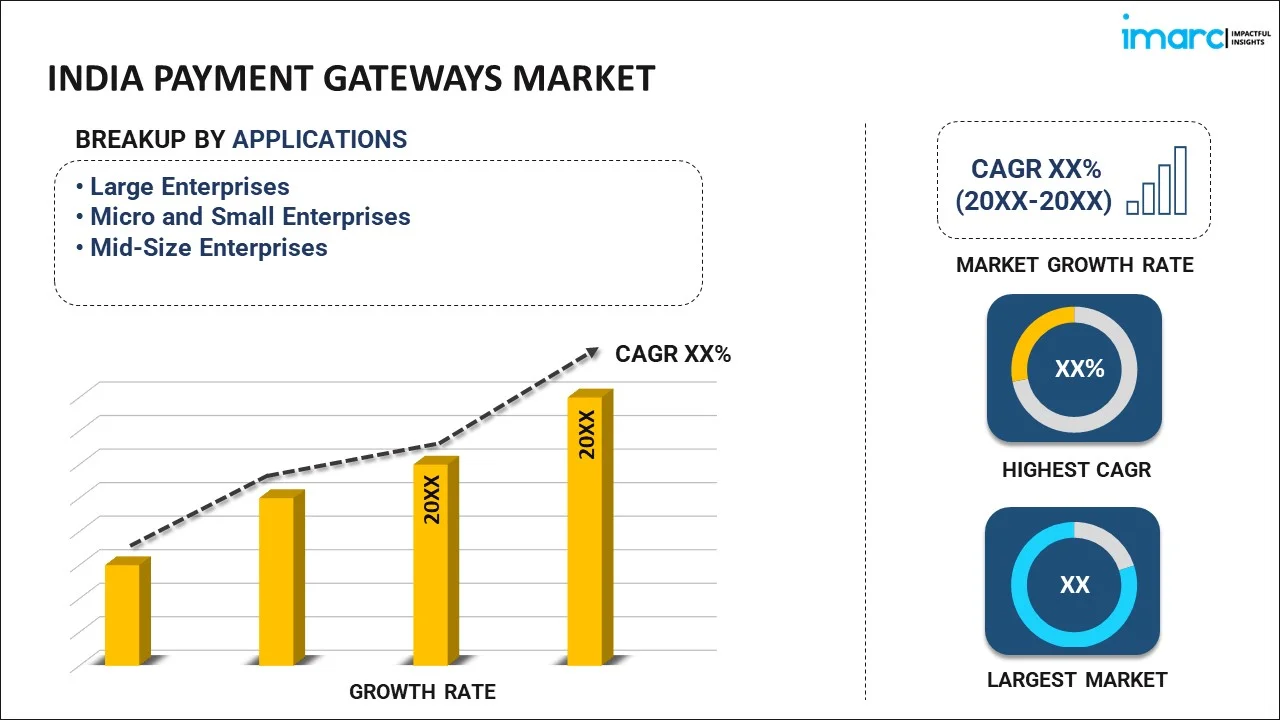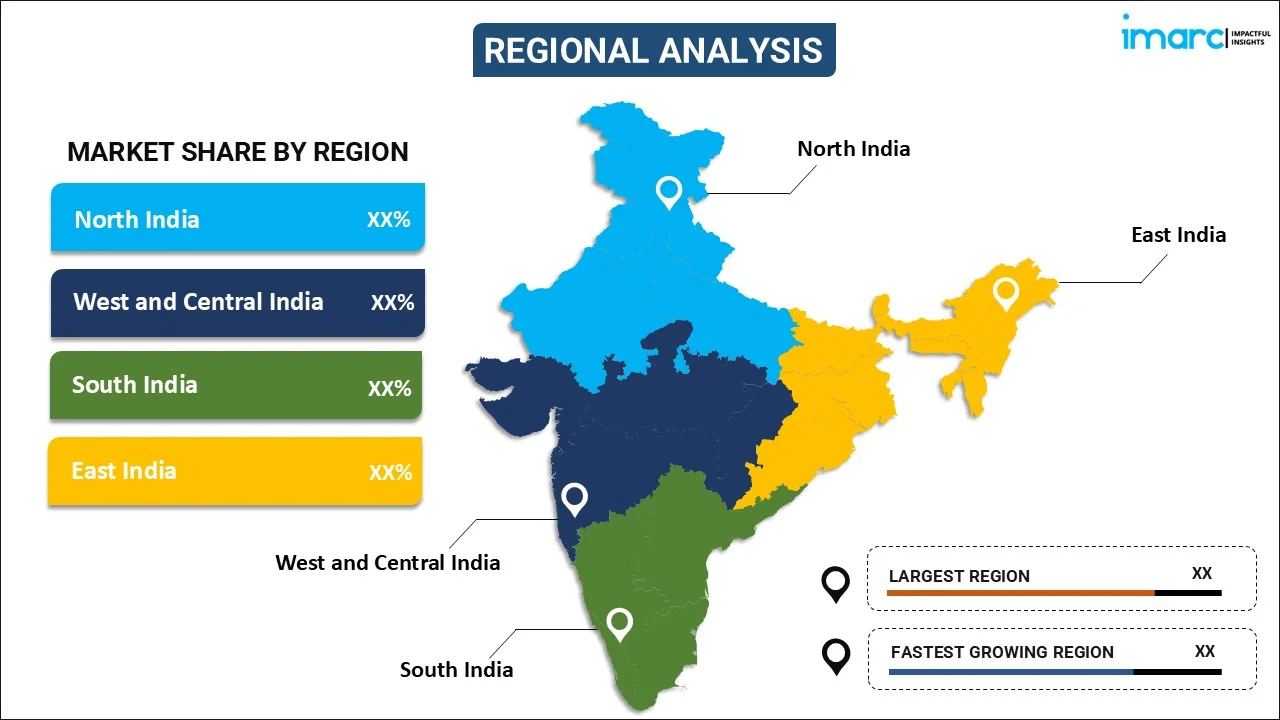
India Payment Gateways Market Report by Application (Large Enterprises, Micro and Small Enterprises, Mid-Size Enterprises), Mode of Interaction (Hosted Payment Gateways, Pro/Self-Hosted Payment Gateways, API/Non-Hosted Payment Gateways, Local Bank Integrates, Direct Payment Gateways, Platform-Based Payment Gateways), and Region 2025-2033
Market Overview:
The India payment gateways market size reached USD 1,793.5 Million in 2024. Looking forward, IMARC Group expects the market to reach USD 4,125.0 Million by 2033, exhibiting a growth rate (CAGR) of 9.70% during 2025-2033. The bolstering e-commerce industry, favorable government initiatives and regulatory standards, and ongoing innovations in digital payment technology represent some of the key factors driving the market.
|
Report Attribute
|
Key Statistics
|
|---|---|
|
Base Year
|
2024
|
|
Forecast Years
|
2025-2033
|
|
Historical Years
|
2019-2024
|
|
Market Size in 2024
|
USD 1,793.5 Million |
|
Market Forecast in 2033
|
USD 4,125.0 Million |
| Market Growth Rate (2025-2033) | 9.70% |
A payment gateway is an online payment processing technology that authorizes and facilitates transactions between a merchant and a customer. It acts as a secure interface between the merchant's website and the payment processor, allowing customers to make electronic payments using various payment methods such as credit cards, debit cards, net banking, e-wallets, and more. The payment gateway securely collects the customer's payment information, encrypts it, and sends it to the payment processor for verification and approval. After the payment is authorized, it communicates the transaction status to the merchant and the customer. Payment gateways prevent fraud, ensure payment security, and simplify the payment process for the merchant and the customer. In addition to this, the solution has made e-commerce more accessible to small businesses and individuals, thus forming an essential part of the digital economy.
India Payment Gateways Market Trends:
Rapid digitalization and the bolstering growth of the e-commerce sector in India are resulting in a surge in demand for online payment solutions, which, in turn, is primarily driving the market growth. Besides this, the increasing penetration of smartphones and high-speed internet services, and the convenience and safety associated with online transactions, are further supporting the market growth. Moreover, the introduction of several initiatives by the Government of India (GoI), such as the Digital India program and the demonetization drive to promote digital payments and reduce cash transactions, are creating a favorable outlook for the market. Concurrent with this, the government has also implemented several regulations, such as the mandatory use of two-factor authentication for online transactions, which have improved the security of online payments and increased the adoption of payment gateways. In addition to this, the flourishing gig economy in the country, the growing number of tech-savvy individuals, and the rising popularity of online gaming and entertainment are aiding in market expansion. In line with this, the proliferation of numerous digital wallets, such as Paytm, PhonePe, and Google Pay, and the emergence of token systems and cash pooling are providing remunerative growth opportunities for the market. Furthermore, ongoing innovations in payment technology, such as the integration of blockchain technology and artificial intelligence (AI), and the advent of internet banking, unified payments interface (UPI), and quick response (QR) codes are strengthening the market growth.
Key Market Segmentation:
IMARC Group provides an analysis of the key trends in each sub-segment of the India payment gateways market report, along with forecasts at the country and regional level from 2025-2033. Our report has categorized the market based on application and mode of interaction.
Application Insights:

- Large Enterprises
- Micro and Small Enterprises
- Mid-Size Enterprises
The report has provided a detailed breakup and analysis of the India payment gateways market based on the application. This includes large, micro and small, and mid-size enterprises. According to the report, large enterprises represented the largest segment.
Mode of Interaction Insights:
- Hosted Payment Gateways
- Pro/Self-Hosted Payment Gateways
- API/Non-Hosted Payment Gateways
- Local Bank Integrates
- Direct Payment Gateways
- Platform-Based Payment Gateways
A detailed breakup and analysis of the India payment gateways market based on the mode of interaction has also been provided in the report. This includes hosted, pro/self-hosted, API/non-hosted, local bank integrates, direct, and platform-based payment gateways. According to the report, hosted accounted for the largest market share.
Regional Insights:

- North India
- West and Central India
- South India
- East India
The report has also provided a comprehensive analysis of all the major regional markets, which include North, West and Central, South, and East India. According to the report, West and Central India was the largest market for India payment gateways. Some of the factors driving the West and Central India payment gateways market in India included the expanding e-commerce sector, favorable government initiatives, and ongoing advancements in payment technology.
Competitive Landscape:
The report has also provided a comprehensive analysis of the competitive landscape in the India payment gateways market. Competitive analysis such as market structure, market share by key players, player positioning, top winning strategies, competitive dashboard, and company evaluation quadrant has been covered in the report. Also, detailed profiles of all major companies have been provided. For each of the companies covered, the report provides business overview, services offered, business strategies, financials, SWOT analysis, and major news and events.
Report Coverage:
| Report Features | Details |
|---|---|
| Base Year of the Analysis | 2024 |
| Historical Period | 2019-2024 |
| Forecast Period | 2025-2033 |
| Units | Million USD |
| Segment Coverage | Application, Mode of Interaction, Region |
| Region Covered | North India, West and Central India, South India, East India |
| Customization Scope | 10% Free Customization |
| Post-Sale Analyst Support | 10-12 Weeks |
| Delivery Format | PDF and Excel through Email (We can also provide the editable version of the report in PPT/Word format on special request) |
Key Benefits for Stakeholders:
- IMARC’s report offers a comprehensive quantitative analysis of various market segments, historical and current market trends, market forecasts, and dynamics of the India payment gateways market from 2019-2033.
- The research study provides the latest information on the market drivers, challenges, and opportunities in the India payment gateways market.
- The study maps the leading, as well as the fastest-growing, regional markets.
- Porter's five forces analysis assists stakeholders in assessing the impact of new entrants, competitive rivalry, supplier power, buyer power, and the threat of substitution. It helps stakeholders to analyze the level of competition within the India payment gateways industry and its attractiveness.
- Competitive landscape allows stakeholders to understand their competitive environment and provides an insight into the current positions of key players in the market.
Key Questions Answered in This Report
The India payment gateways market was valued at USD 1,793.5 Million in 2024.
We expect the India payment gateways market to exhibit a CAGR of 9.70% during 2025-2033.
The rising number of online transactions, along with the widespread adoption of payment gateways by individuals to make purchases at any hour of the day without the inconvenience of waiting in long queues, is primarily driving the India payment gateways market.
The sudden outbreak of the COVID-19 pandemic has led to the changing consumer inclination from cash-based transactions towards online payment gateways to mitigate the risk of the coronavirus infection upon human intervention.
Based on the application, the India payment gateways market has been segmented into large enterprises, micro and small enterprises, and mid-size enterprises. Currently, large enterprises hold the majority of the total market share.
Based on the mode of interaction, the India payment gateways market can be divided into hosted payment gateways, pro/self-hosted payment gateways, API/non-hosted payment gateways, local bank integrates, direct payment gateways, and platform-based payment gateways. Among these, hosted payment gateways exhibit a clear dominance in the market.
On a regional level, the market has been classified into North India, West and Central India, South India, and East India, where West and Central India currently dominates the India payment gateways market.
Need more help?
- Speak to our experienced analysts for insights on the current market scenarios.
- Include additional segments and countries to customize the report as per your requirement.
- Gain an unparalleled competitive advantage in your domain by understanding how to utilize the report and positively impacting your operations and revenue.
- For further assistance, please connect with our analysts.
 Inquire Before Buying
Inquire Before Buying
 Speak to an Analyst
Speak to an Analyst
 Request Brochure
Request Brochure
 Request Customization
Request Customization




.webp)




.webp)












